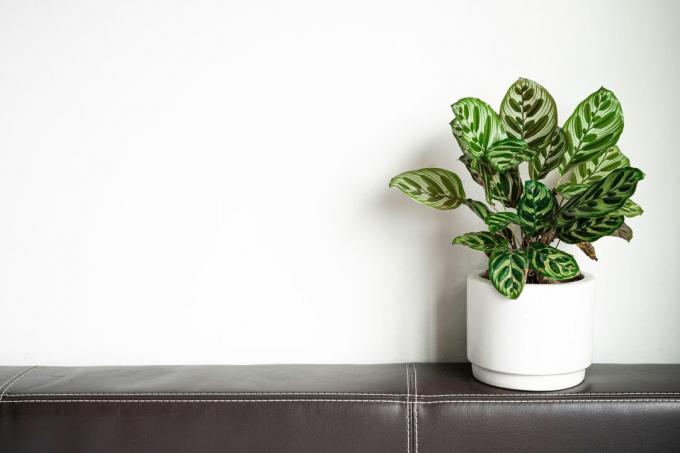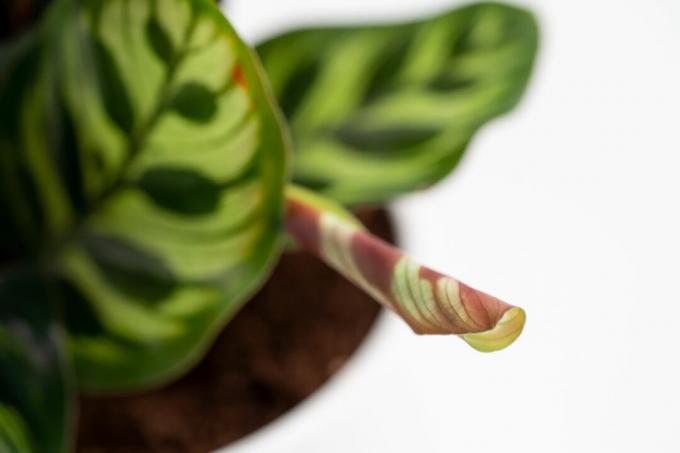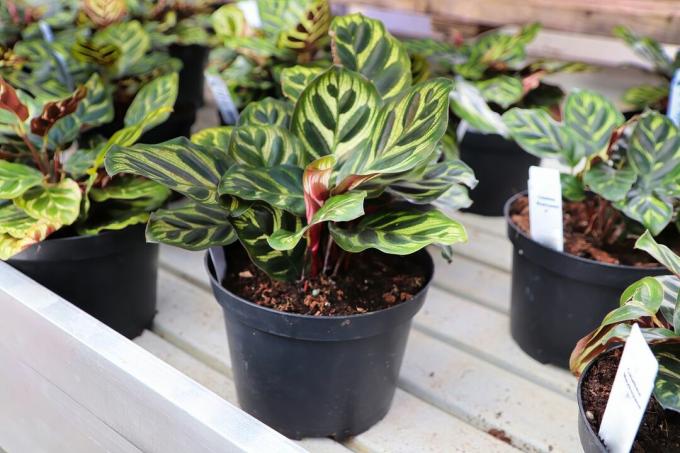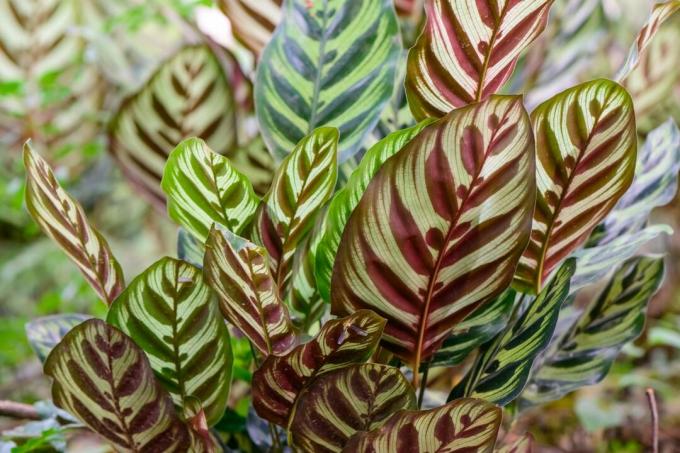The peacock basket marante is a rather small one calathea with decorative, colorful leaves. It's not easy to maintain, but it's definitely worth the effort.

With its strikingly patterned leaves, the Calathea makoyana straight in the eye. In the right location, it usually develops splendidly and presents its foliage for a long time before the pattern and color fade with age.
contents
- Calathea makoyana: flowering, origin and properties
- Location, soil and co. for the houseplant
- Calathea makoyana care: the main measures
- propagation
- Is the peacock garnet poisonous?
Calathea makoyana: flowering, origin and properties
The Peacock Basket Marante (Calathea makoyana), often referred to simply as wicker marante, is native to Brazil where it is found in moist, shady rainforests. Due to its decorative leaves, it is very popular as a houseplant in temperate latitudes. However, caring for them is a bit demanding and requires a certain amount of finesse to keep the peacock cinnamon healthy. The bushy plant reaches heights of 30 to 50 cm and forms leaves up to 15 cm in size, which are patterned in different shades of green. The underside of the leaf is reddish-violet in colour. Since the leaves of
basket marants (calathea) roll up at night, you can enjoy the colored underside. The leaves of the peacock basket marant sit on thin stalks that arise from the bulbous rhizome. If the Calathea makoyana is kept as a houseplant, its flowers are rarely seen. The yellow spikes of flowers appear in January and February in the natural habitat of the peacock basket.
Location, soil and co. for the houseplant
The conditions for the houseplant should look similar to the tropical natural location of the peacock basket marante. the Calathea makoyana needs a location in the semi-shade without direct sun. A little light is tolerated at most in the evening or morning hours. In addition, it should be sufficiently warm all year round. The peacock basket marante needs high temperatures of 23 to 25 °C during the growth period. In winter it should be a little cooler, but not colder than 18 °C. High humidity is for the Calathea makoyana a must. This can be achieved, for example, by filling the saucer of the peacock basket marante with expanded clay and a little water and then placing the pot on the expanded clay. The plant does not stand directly in the wet, but only benefits from the evaporation in the immediate vicinity. Alternatively, you can spray the peacock basket marante with water every day. However, this can lead to lime stains on the leaves.

After purchase, the Calathea makoyana planted in a suitable substrate. A nutrient-rich and humic, rather coarse soil with a slightly acidic pH range is ideal. A suitable soil is therefore ours, for example Plantura organic universal soil, which is also made without the use of peat and retains a loose, permeable structure. Since the Calathea makoyana Waterlogging is poorly tolerated, 1 part expanded clay should be mixed with 2 parts soil. The expanded clay can be used directly to create a drainage layer at the bottom of the pot, through which excess water can drain off easily.
Tip: In order to lower the pH value of the substrate a bit, you can add a little pine litter, acidic bedrock powder or pine bark to the soil.
Calathea makoyana care: the main measures
Among the basic measures of Calathea makoyana-Maintenance includes watering and fertilizing. The peacock basket marante requires even soil moisture and must be watered regularly, especially during the growing season. The substrate should always be slightly damp to the touch, but not waterlogged - this is best prevented with the drainage layer mentioned above. In winter, less water is poured, but the root ball must not dry out under any circumstances. Ideally, soft rainwater should be used for watering, as tap water is usually too hard and contains too much lime and thus hinders the roots’ nutrient uptake in the long term.
Tip: Providing a high level of humidity is also an important precaution, since the peacock basket marant is often attacked by spider mites in dry air.
Fertilize every 2 weeks from spring to autumn, preferably with a liquid fertilizer that is easy to put into the soil. For example, our is suitable for this Plantura organic indoor and green plant fertilizer. In addition to important nutrients, this contains microorganisms that promote root growth of the peacock basket marante. Fertilization is not necessary in winter.

The needs a pruning Calathea makoyana not. If yellow or dried leaves are found on the plant, these can be cut off at the base.
Every year in spring it is time to repot the peacock basket marante. The new pot should only be one size larger than the old one. Lift the plant out of the old pot and carefully remove the substrate from the roots. If rotten or dried roots are found, cut them off with a sharp knife. A drainage layer is laid in the new pot again and fresh substrate is filled in before the peacock basket marante is planted. For older and larger plants, repotting is the ideal time to Calathea makoyana to multiply.

propagation
the Calathea makoyana is best propagated by division. In late spring, when growth has resumed, or for repotting, the peacock rosette is lifted out of the pot and the root ball is freed from the substrate. At this point, the root ball can be carefully separated into 2 parts, if necessary using a knife. Both parts should have some leaves and are then planted in 2 separate pots. Sufficient warmth and humidity must be ensured, especially after division, so that the plants grow well.
Is the peacock garnet poisonous?
the Calathea makoyana is non-toxic, but not suitable for consumption. There is no need to worry about pets in the presence of the peacock basket marante.

The mosaic plant (Fittonia albivenis). But it is also easier to care for than that calathea and good for beginners. With us you will learn how to do it Plant and care for the mosaic plant.
